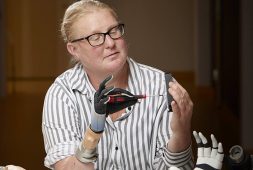
Oncologists now have a cutting-edge resource in their arsenal for combating liver cancers, thanks to a pioneering solution that seamlessly integrates academia and marketplace elements. This innovative approach employs high-energy acoustics to effectively obliterate tumors using sound waves.
Referred to as “histotripsy,” this groundbreaking method, along with its associated machinery, has not only undergone successful testing in both animal and human subjects but has also received the stamp of approval from the Food and Drug Administration (FDA) for clinical use.
At the forefront of this medical advancement is HistoSonics, a company established in 2009 with the explicit goal of developing an ultrasound device capable of both tumor screening and the administration of histotripsy. The company’s inception can be traced back to the collaborative efforts of scientists at the University of Michigan, who played pivotal roles in co-founding the organization. This interdisciplinary initiative underscores the symbiotic relationship between academic research and practical applications, fostering a seamless transition from scientific discovery to tangible medical solutions.
“Histotripsy is an exciting new technology that, although it is in early stages of clinical use, may provide a noninvasive treatment option for patients with liver cancer. Hopefully it can be combined with systemic therapies for a synergistic therapeutic effect,” said Mishal Mendiratta-Lala. She’s professor of radiology with Michigan Medicine.
Mendiratta-Lala spearheaded a pivotal FDA human trial initiated in 2021 that conclusively validated the efficacy of HistoSonic’s groundbreaking device, known as Edison, in the obliteration of cancerous tumors. The trial affirmed the potential of Edison as a transformative technology in the realm of cancer treatment.

As per information from the University of Michigan Press, histotripsy operates by utilizing focused ultrasound waves to generate microbubbles within a tumor. The resulting forces from the formation and collapse of these bubbles lead to the fragmentation of the mass, effectively eliminating tumor cells and leaving the immune system to clear away the debris.
The distinct advantage of histotripsy lies in its ability to bypass the harm and trauma associated with invasive surgical procedures, as well as the debilitating side effects often accompanying chemotherapy and radiation. This is largely attributed to the use of ultrasound, the same technology employed for visualizing babies in the womb, enabling physicians to precisely target specific tissues for destruction.
Notably, two trials conducted in mice revealed an additional positive outcome. Even if the Edison device could only eliminate 50% or 70% of the tumor tissues, subsequent immune responses in the mice were observed, further deteriorating the tumors.
Cancers are notorious for concealing themselves within a host by exploiting the host’s biological signatures to evade detection by immune cells. The ultrasound’s impact appears to dismantle this defense system, empowering the immune system to identify and eradicate the tumors.
Moreover, this suggests, in theory and as validated by a trial, that in the event of a cancer resurgence, the immune system could treat it as it would any other disease, targeting and addressing it in its early stages. This breakthrough underscores the potential of histotripsy not only as a treatment method but also in bolstering the body’s natural defenses against cancer.
“We want to leverage histotripsy’s immuno stimulation effects and hopefully combine them with immunotherapy or drug delivery,” said Zhen Xu, U-M professor of biomedical engineering. She’s also an inventor of the histotripsy approach and a co-founder of HistoSonics.
“That will move histotripsy from a local therapy into one that can treat tumors globally all over the body and eventually into a cure. In terms of the cancer treatment, that will be the next step, and I feel very excited about the potential.”



